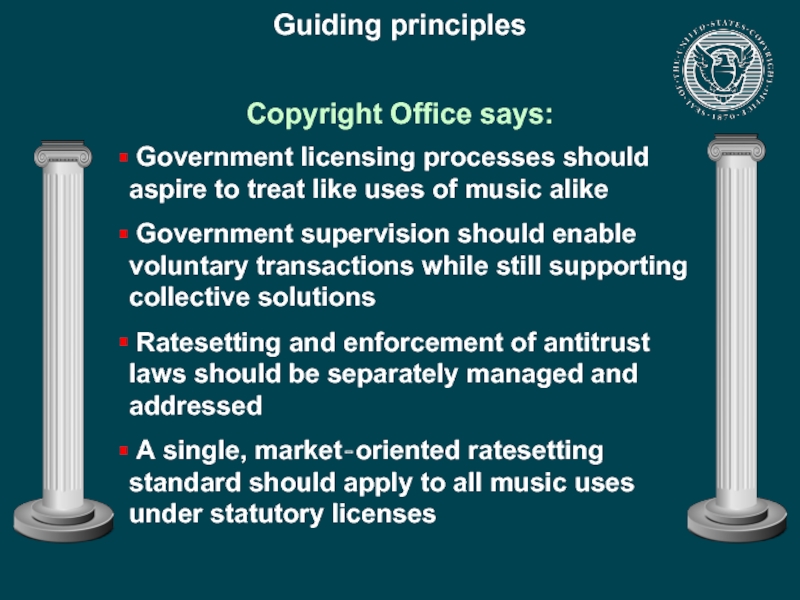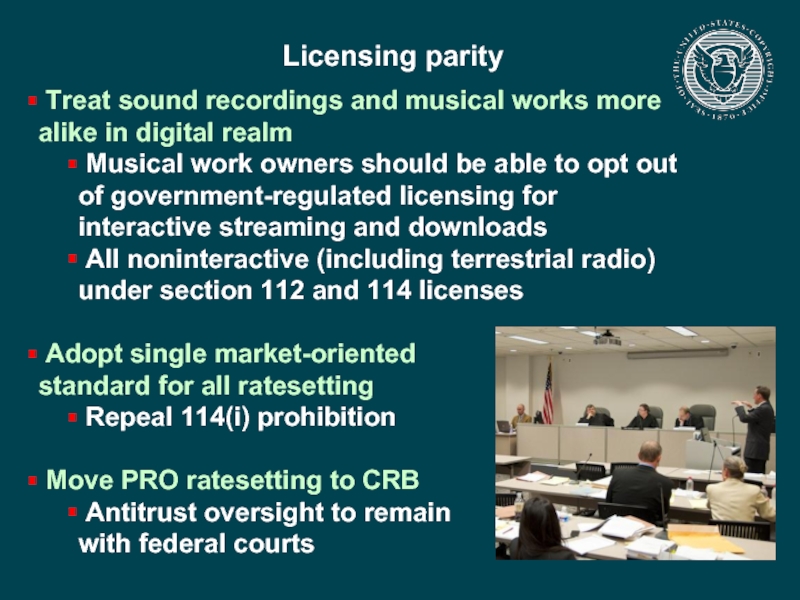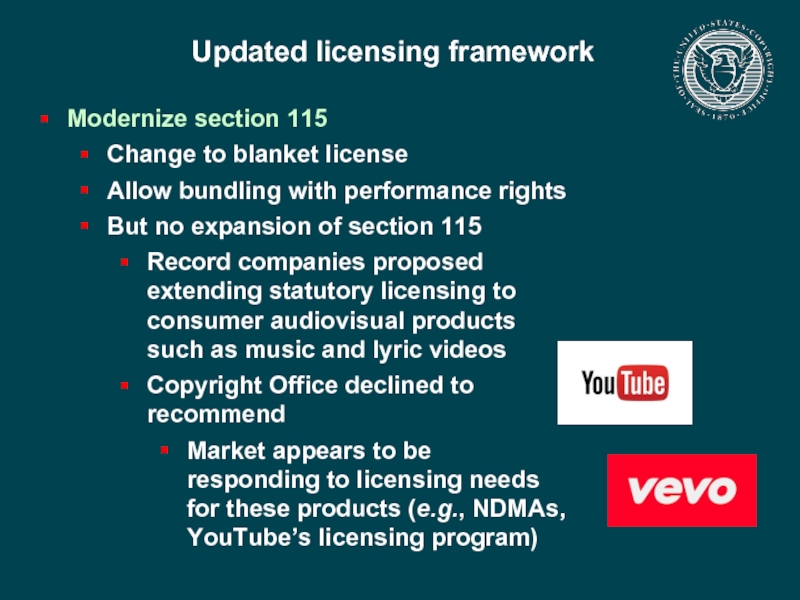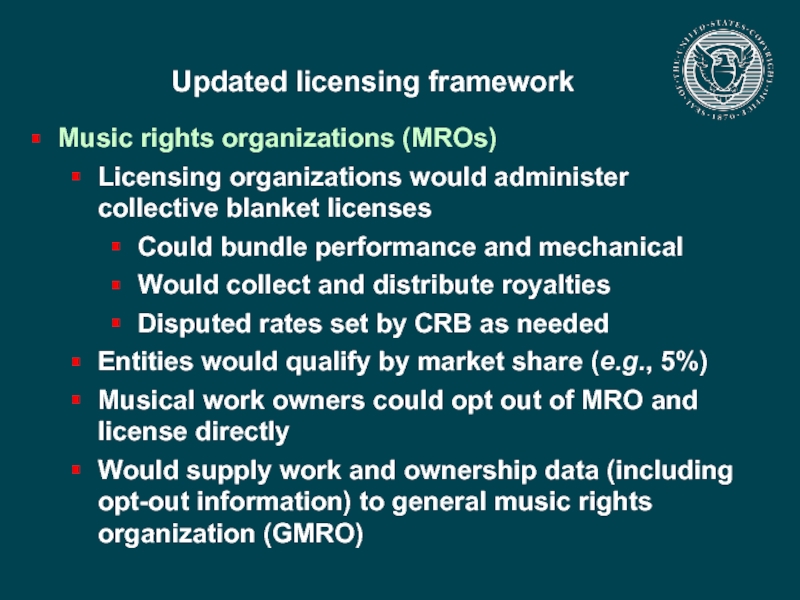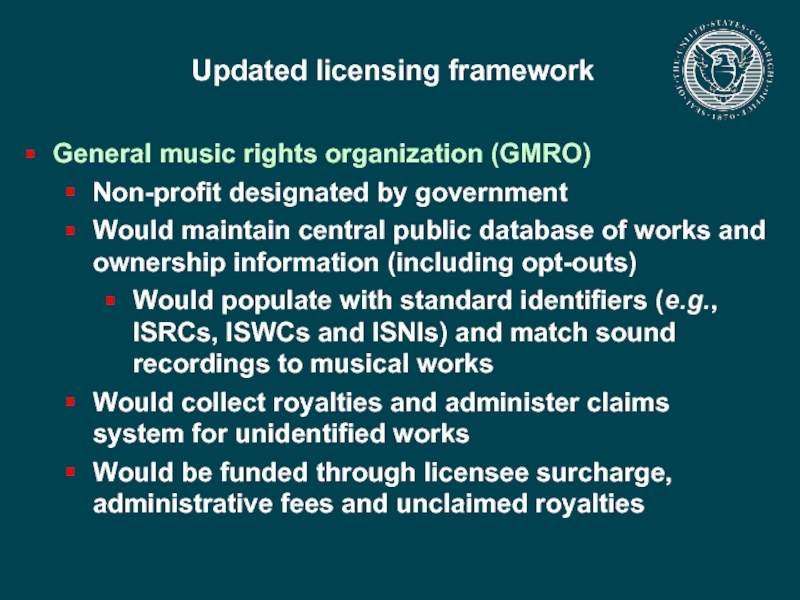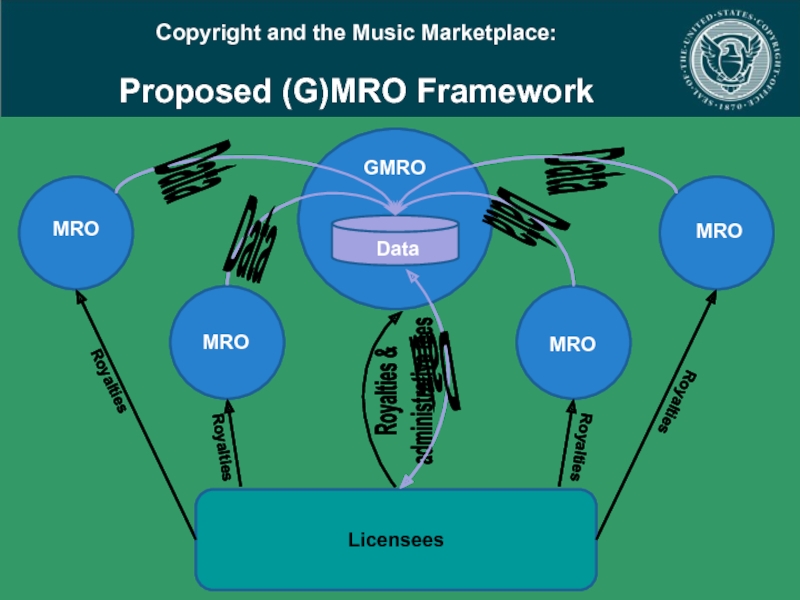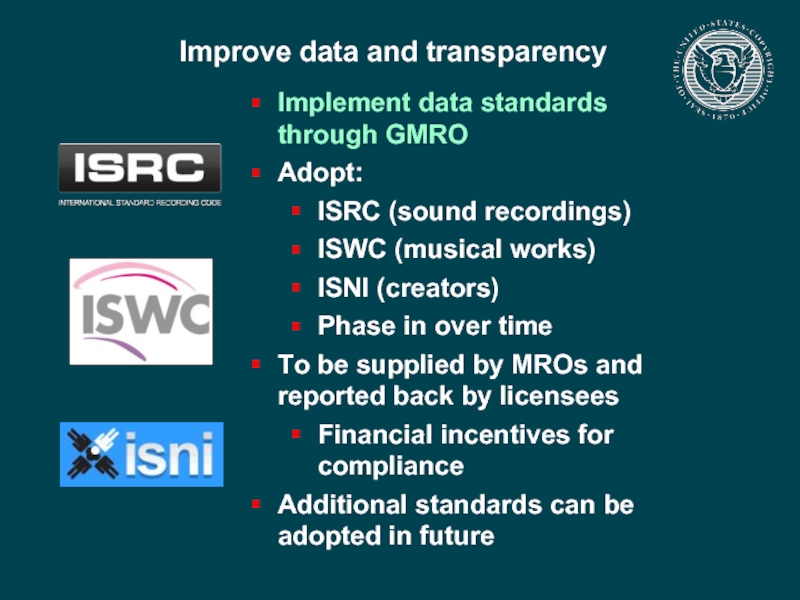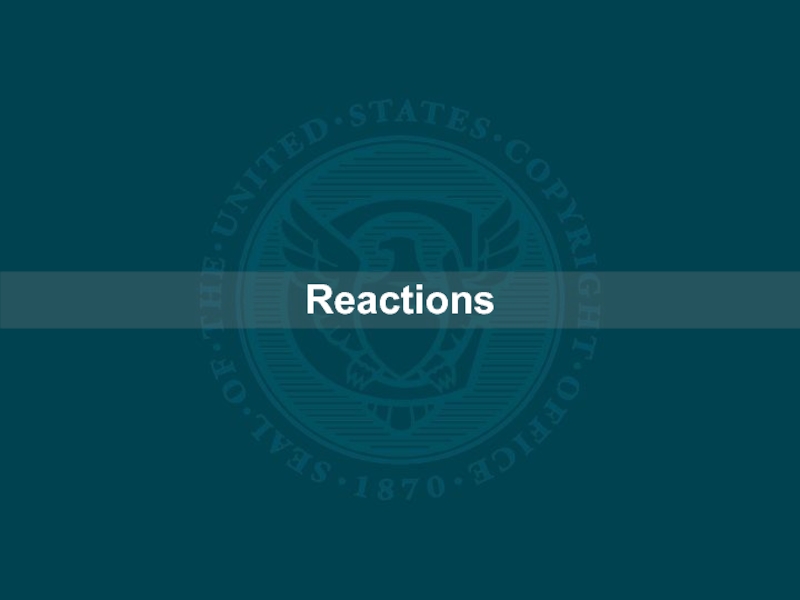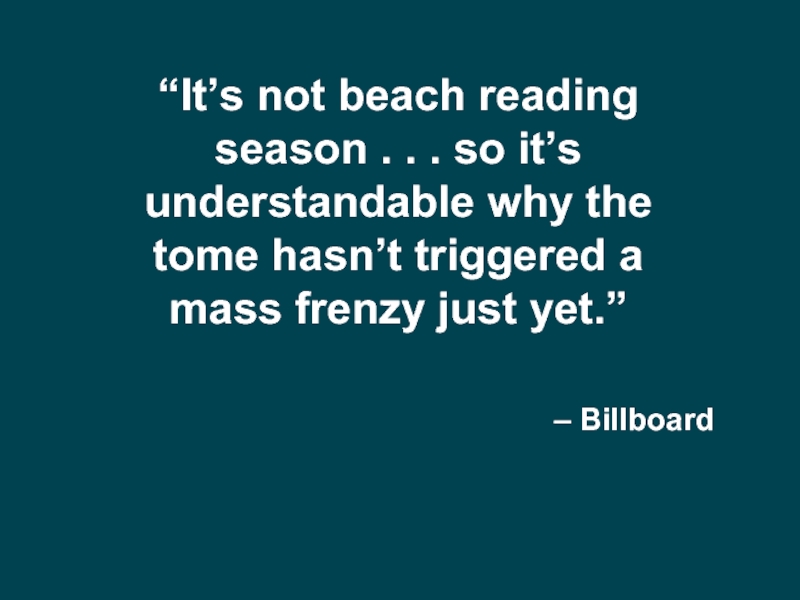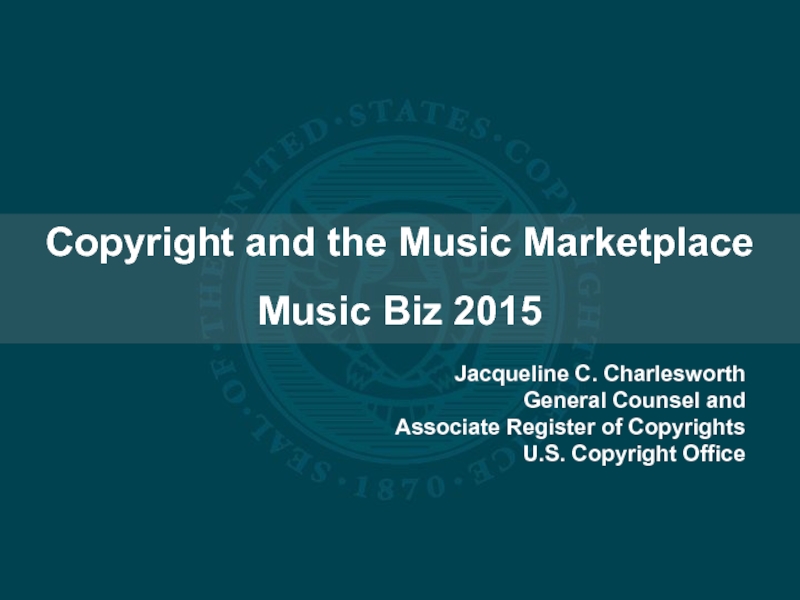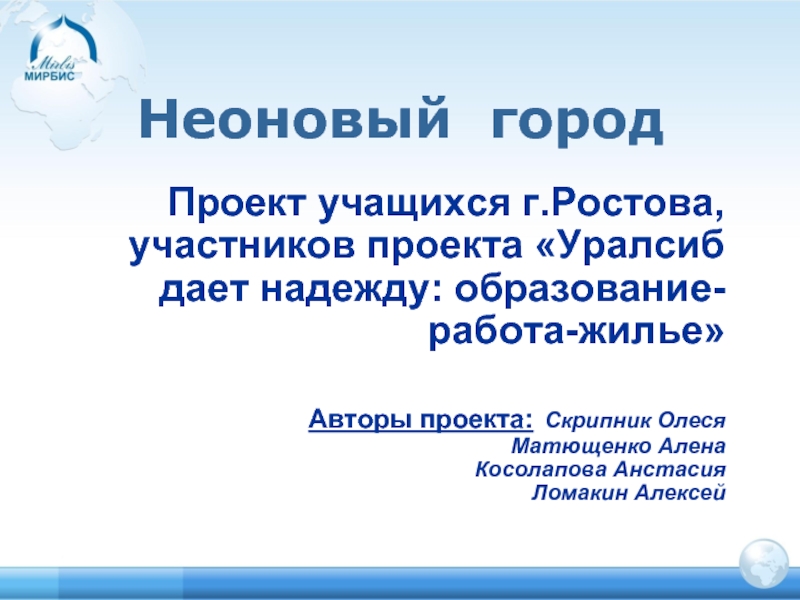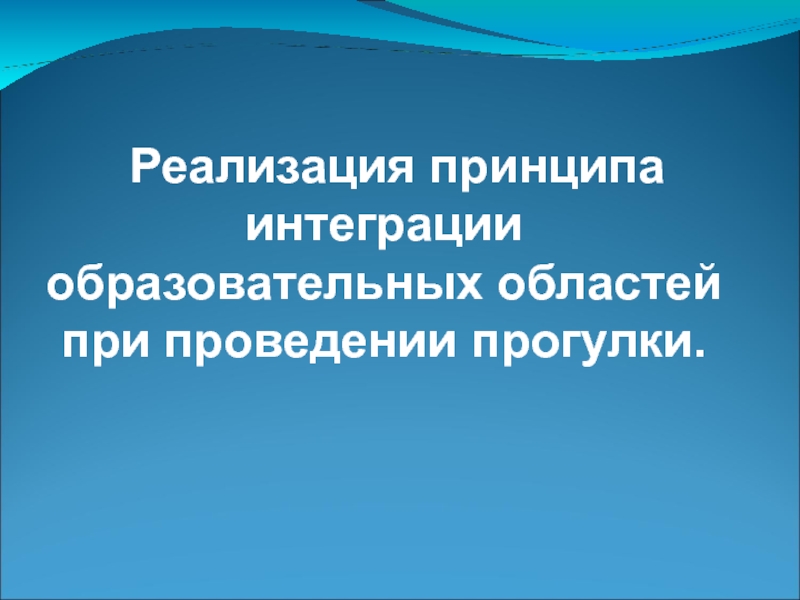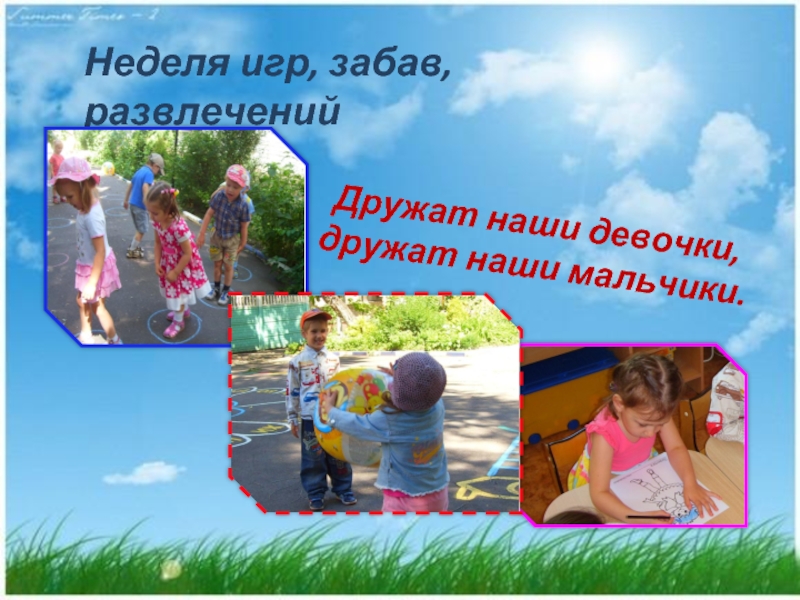- Главная
- Разное
- Дизайн
- Бизнес и предпринимательство
- Аналитика
- Образование
- Развлечения
- Красота и здоровье
- Финансы
- Государство
- Путешествия
- Спорт
- Недвижимость
- Армия
- Графика
- Культурология
- Еда и кулинария
- Лингвистика
- Английский язык
- Астрономия
- Алгебра
- Биология
- География
- Детские презентации
- Информатика
- История
- Литература
- Маркетинг
- Математика
- Медицина
- Менеджмент
- Музыка
- МХК
- Немецкий язык
- ОБЖ
- Обществознание
- Окружающий мир
- Педагогика
- Русский язык
- Технология
- Физика
- Философия
- Химия
- Шаблоны, картинки для презентаций
- Экология
- Экономика
- Юриспруденция
Copyright and the Music Marketplace Music Biz 2015 презентация
Содержание
- 1. Copyright and the Music Marketplace Music Biz 2015
- 2. Background
- 3. Music copyright timeline 1790: Musical compositions protected
- 4. 1941: ASCAP and BMI enter into consent
- 5. Music copyright timeline SIRA 1998: DMCA amends
- 6. Music copyright timeline 2014: California and N.Y.
- 7. Reproduction and distribution (mechanical) rights Public performance
- 8. From physical albums to digital singles
- 9. Rise of streaming
- 10. The current system “From a copyright perspective,
- 11. Music study process Request for public comments
- 12. Issues
- 13. Key concerns Fair compensation for creators Market
- 14. “Avicii’s release ‘Wake
- 15. Role of government regulation
- 16. Disparate ratesetting standards Section 115 mechanical (musical
- 17. Rate disparities: Sound recordings vs. musical works
- 18. Section 115 license Section 115 mechanical license
- 19. PRO consent decrees Consent decrees Entered in
- 20. Section 112 and 114 licenses Administered by
- 21. Pre-1972 sound recordings Only sound
- 22. Flo & Eddie Inc. v.
- 23. Terrestrial performance right Federal law
- 24. Data issues Lack of authoritative
- 25. Reporting transparency Hard for creators
- 26. Related developments
- 27. Recent legislative proposals “[RESPECT] Act” (H.R. 4772)
- 28. Recommendations
- 29. Music creators should be fairly compensated
- 30. Government licensing processes should aspire to
- 31. Licensing parity Treat sound recordings and
- 32. Licensing parity Enact complete sound recording performance
- 33. Modernize section 115 Change to blanket license
- 34. Maintain section 112 and 114 licenses
- 35. Music rights organizations (MROs) Licensing organizations would
- 36. General music rights organization (GMRO) Non-profit designated
- 37. Licensees GMRO MRO Data
- 38. Improve data and transparency Implement data standards
- 39. Improve data and transparency Creators able to
- 40. Reactions
- 41. How long is this report again? 250
- 42. “It’s not beach reading season . .
- 43. Copyright and the Music Marketplace Music Biz
Слайд 1Copyright and the Music Marketplace
Music Biz 2015
Jacqueline C. Charlesworth
General Counsel and
Associate Register of Copyrights
U.S. Copyright Office
Слайд 3Music copyright timeline
1790: Musical compositions protected as “books”
1831: Rights granted for
1897: Rights granted for
the public performance of musical works
1908: Supreme Court decides White‐Smith v. Apollo, holding mechanical reproductions
are not copies
Слайд 41941: ASCAP and BMI enter into consent decrees with the DOJ
1972:
1976: Mechanical compulsory license recodified in section 115; increased statutory rate to 2.75 cents
Music copyright timeline
1909: Congress grants rights for mechanical reproductions in phonorecords and enacts compulsory license with a
2 cent rate
Слайд 5Music copyright timeline
SIRA
1998: DMCA amends section 114 license to include internet
2006: SIRA introduced to modernize 115 license for digital uses, but does not become law
DMCA
1995: DPRSRA enacted; granting digital sound recording performance right codified in section 114
Слайд 6Music copyright timeline
2014: California and N.Y. courts hold public performance of
state law
The Turtles
2013: Federal rate courts rule that publishers cannot withdraw digital rights from ASCAP and BMI consent decrees
2015: U.S. Copyright Office releases report, “Copyright and the Music Marketplace”
Слайд 7Reproduction and distribution
(mechanical) rights
Public performance rights
Synch
rights,
etc.
Musical Work
Synch
rights,
etc.
Public
performance
rights
noninteractive
Downloads,
interactive streaming,
CDs, etc.
Downloads,
interactive
streaming,
CDs, etc.
Publishers
directly
Traditional media
(radio, TV, etc.)
and new media
(internet, etc.)
Traditional
media
(TV, film, etc.)
and new media
(internet, etc.)
Publishers
directly or
through
labels
Statutory
notice
Live
Copyright and the Music Marketplace:
Existing Licensing Framework
Public
performance
rights for
terrestrial
(AM/FM)
radio
No federal
performance
right
Labels
directly
Internet and
satellite
radio, etc.
Traditional media
(TV, film, etc.)
and new media
(internet, etc.)
Reproduction and
distribution rights,
and public
performance
rights for digital
interactive
Labels
directly
Слайд 10The current system
“From a copyright perspective, we are trying to deliver
bits
Слайд 11Music study process
Request for public comments
(Mar. 17, 2014)
Public
Request for additional comments (July 23, 2014)
Report released (Feb. 5, 2015)
NYC Roundtable
Слайд 13Key concerns
Fair compensation for creators
Market trends
Disparate treatment of rights and uses
Licensing
Regulated vs. nonregulated
Ratesetting standards
Musical works
PRO consent decrees
Section 115 license
Sound recordings
Section 112/114 license
Terrestrial performance right
Pre-72 sound recordings
Data issues
Reporting transparency
Слайд 14
“Avicii’s release ‘Wake
Me Up!’
and sing … [is] the 13th
most played song on Pandora since its release in 2013, with more than 168 million streams in the US. … In return for co‐writing a major hit song, I’ve earned less than $4,000 domestically from the largest digital music service.”
– Aloe Blacc
“Everybody’s complaining about how music sales are shrinking, but nobody’s changing the way they’re doing things.”
– Taylor Swift
Creator income
Слайд 16Disparate ratesetting standards
Section 115 mechanical (musical works)
Section 114 satellite radio
Section 801(b)(1) multifactor standard
Policy-oriented standard that can result in below-market rates
Copyright Royalty Board
Section 114 internet radio (sound recordings)
“Willing buyer/willing seller” standard
Designed to emulate marketplace rates
Applies to section 114 internet radio (sound recordings)
Copyright Royalty Board
PRO consent decrees (ASCAP or BMI’s musical works)
“Reasonable rate” standard determined under “fair market value” analysis with reference to antitrust principles
Court cannot consider sound recording performance rates (section 114(i))
S.D.N.Y. rate courts
Слайд 18Section 115 license
Section 115 mechanical license originally enacted in 1909
Congress
Burdensome song-by-song licensing
801(b)(1) standard perceived as unfair by some
No audit right
Record labels license these rights in free market
Слайд 19PRO consent decrees
Consent decrees
Entered in 1941
Rates set by S.D.N.Y. “rate courts”
Right to perform musical works in a PRO’s repertoire upon application without immediate payment
Other PROs and record labels not subject to consent decrees
Pandora decisions
Denied partial withdrawal of “new media” rights – publishers must be “all in” or “all out”; decisions appealed
ASCAP rate set below negotiated rates; BMI trial just ended
DOJ reviewing decrees for potential modification
Considering partial withdrawal, bundling of rights
Слайд 20Section 112 and 114 licenses
Administered by SoundExchange
Appear to be functioning fairly
Debate on royalty rates
Services want lower rates, creators want higher rates
Webcasters have gone twice to Congress for relief from CRB-set rates (2007, 2012)
Treatment of customized services (e.g., Pandora) as
noninteractive
In 2009, the Second Circuit held that personalization did not mean a service was “specially created for the recipient.” Arista Records, LLC v. Launch Media, Inc., 578 F.3d 148 (2d Cir. 2009)
No license termination provision for delinquent licensees
Technical limits of section 112 (e.g., destroy copies in 6 months)
Слайд 21Pre-1972 sound recordings
Only sound recordings fixed on or after Feb.
State law protection varies
In 2011 report, Copyright Office recommended full federalization of pre-72 recordings
Слайд 22
Flo & Eddie Inc. v. Sirius XM, No. 13‐cv‐5693 (C.D.
California law (Cal. Civ. Code 980(a)(2)) recognizes performance right in pre-72 recordings
Capitol Records, LLC v. Sirius XM, No. BC520981 (Cal. Super. Ct. Oct. 14, 2014)
Adopted federal court’s reading of California statute
Flo & Eddie Inc. v. Sirius XM, No. 13‐cv‐5784 (S.D.N.Y. Nov. 14, 2014)
Public performance of pre-1972 sound recordings constitutes common law copyright infringement and unfair competition under New York law
Currently on appeal
Other cases hold pre-72 recordings fall outside of DMCA safe harbor
See, e.g., Capitol Records, LLC v. Vimeo, LLC, 972 F. Supp. 2d 500 (S.D.N.Y. 2013); UMG Recordings, Inc. v. Escape Media Grp., Inc., 107 A.D.3d 51, 964 N.Y.S.2d 106 (1st Dep't 2013)
Pre-1972 sound recordings
Слайд 23Terrestrial performance right
Federal law does not recognize a terrestrial performance
Radio is a $17 billion industry
Artists and sound recording owners not paid
Curtails reciprocal international royalties
Unfair to competing, non-exempt internet radio and satellite providers
Copyright Office has supported sound recording performance right since before 1976 Act
Слайд 24Data issues
Lack of authoritative centralized music database
30 million musical
Manual research often required
Challenge of matching sound recordings to musical works
Data managed by different stakeholders – use of standard identifiers (e.g., ISRC, ISWC, ISNI) inconsistent
Industry participants view data as proprietary
Inefficient for both users and owners
Слайд 25Reporting transparency
Hard for creators and owners to track usage and
Unreliable and missing data
Reporting and payment of advances unclear
Role of equity deals (e.g., Spotify)
Concerns about writers’ and artists’ shares under direct deals
Lack of audit rights
$ 00.000002
Слайд 27Recent legislative proposals
“[RESPECT] Act” (H.R. 4772) introduced by
Rep. Holding
(17
“Allocation for Music Producers Act” (H.R. 1457) introduced by Rep. Crowley (1 cosponsor)
“Fair Play
Fair Pay Act
of 2015”
(H.R. 1733) introduced by Rep. Nadler
(7 cosponsors)
“Protecting the Rights of Musicians Act”
(H.R. 1999) introduced by Rep. Blackburn
(1 cosponsor)
“Songwriter Equity Act” (H.R. 1283, S. 662) introduced by Rep. Collins
(14 cosponsors) and Sen. Hatch
(3 cosponsors)
Слайд 29 Music creators should be fairly compensated for their contributions
The
Market participants should have access to authoritative data to identify and license sound recordings and musical works
Usage and payment information should be transparent and accessible to rightsowners
Guiding principles
Stakeholders agree:
Слайд 30 Government licensing processes should aspire to treat like uses of
Government supervision should enable voluntary transactions while still supporting collective solutions
Ratesetting and enforcement of antitrust laws should be separately managed and addressed
A single, market‐oriented ratesetting standard should apply to all music uses under statutory licenses
Guiding principles
Copyright Office says:
Слайд 31Licensing parity
Treat sound recordings and musical works more alike in
Musical work owners should be able to opt out of government-regulated licensing for interactive streaming and downloads
All noninteractive (including terrestrial radio) under section 112 and 114 licenses
Adopt single market-oriented
standard for all ratesetting
Repeal 114(i) prohibition
Move PRO ratesetting to CRB
Antitrust oversight to remain
with federal courts
Слайд 32Licensing parity
Enact complete sound recording performance right
Include under section 112
Promotional value of radio can be taken into account by CRB
Protect pre-72 sound recordings under federal law
Adopt Office’s 2011 recommendations for full federalization
Would eliminate need for state-by-state compliance
Would promote licensing parity
Слайд 33Modernize section 115
Change to blanket license
Allow bundling with performance rights
But no
Record companies proposed extending statutory licensing to consumer audiovisual products such as music and lyric videos
Copyright Office declined to recommend
Market appears to be responding to licensing needs for these products (e.g., NDMAs, YouTube’s licensing program)
Updated licensing framework
Слайд 34
Maintain section 112 and 114 licenses with adjustments
Should also cover noninteractive
Possibility of joint ratesetting for musical works and sound recordings
Technical aspects of license should be fine-tuned by regulation (e.g., ratesetting distinctions between custom and noncustom radio, sound recording performance complement)
Allow SoundExchange to terminate noncompliant licensees
Updated licensing framework
Слайд 35Music rights organizations (MROs)
Licensing organizations would administer collective blanket licenses
Could
Would collect and distribute royalties
Disputed rates set by CRB as needed
Entities would qualify by market share (e.g., 5%)
Musical work owners could opt out of MRO and license directly
Would supply work and ownership data (including opt-out information) to general music rights organization (GMRO)
Updated licensing framework
Слайд 36General music rights organization (GMRO)
Non-profit designated by government
Would maintain central public
Would populate with standard identifiers (e.g., ISRCs, ISWCs and ISNIs) and match sound recordings to musical works
Would collect royalties and administer claims system for unidentified works
Would be funded through licensee surcharge, administrative fees and unclaimed royalties
Updated licensing framework
Слайд 37
Licensees
GMRO
MRO
Data
Royalties
Royalties &
administrative fees
Data
Data
Data
Copyright and the Music Marketplace:
Proposed (G)MRO Framework
MRO
MRO
MRO
Data
Data
Royalties
Royalties
Royalties
Слайд 38Improve data and transparency
Implement data standards through GMRO
Adopt:
ISRC (sound
ISWC (musical works)
ISNI (creators)
Phase in over time
To be supplied by MROs and reported back by licensees
Financial incentives for compliance
Additional standards can be adopted in future
Слайд 39Improve data and transparency
Creators able to collect writers’ and artists’ shares
Would include direct opt-out deals
Material financial terms of direct deals should be disclosed
Publishers and record labels should develop best practices with creators
Слайд 42“It’s not beach reading season . . . so it’s understandable
tome hasn’t triggered a
mass frenzy just yet.”
– Billboard
Слайд 43Copyright and the Music Marketplace
Music Biz 2015
Jacqueline C. Charlesworth
General Counsel and
Associate Register of Copyrights
U.S. Copyright Office
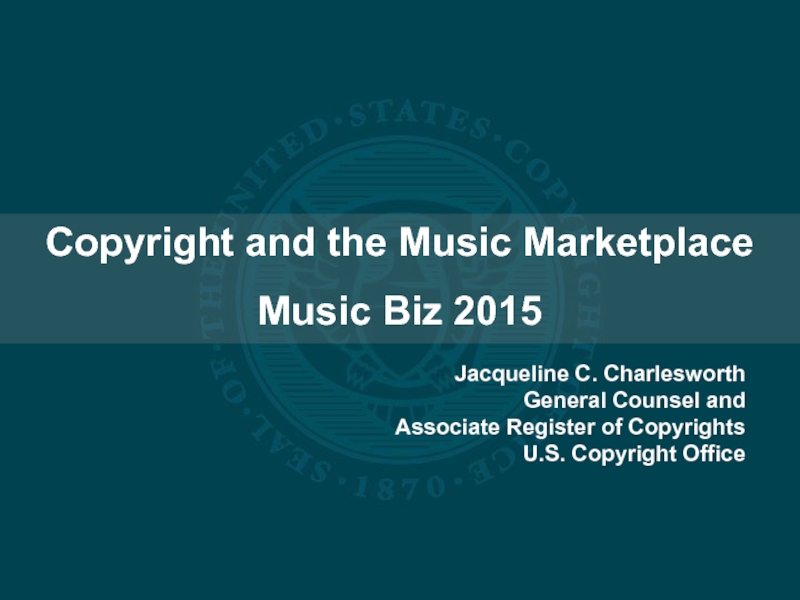

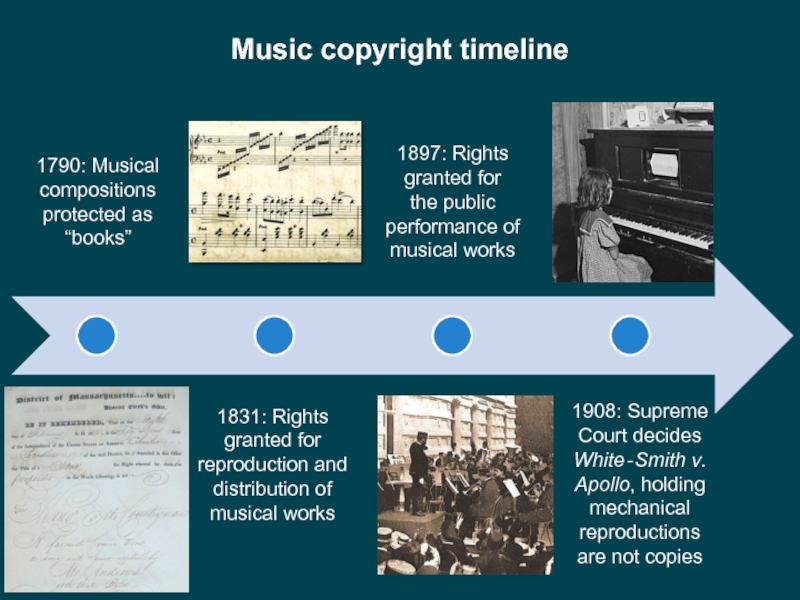
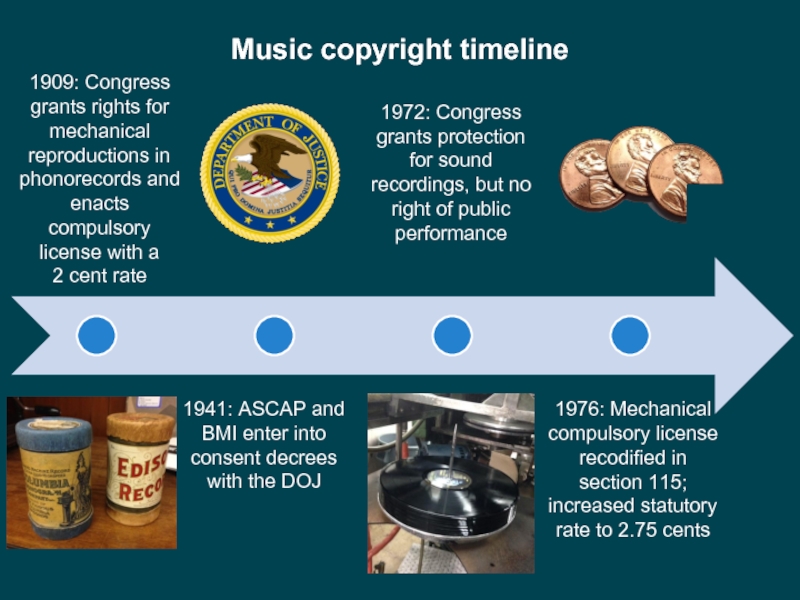
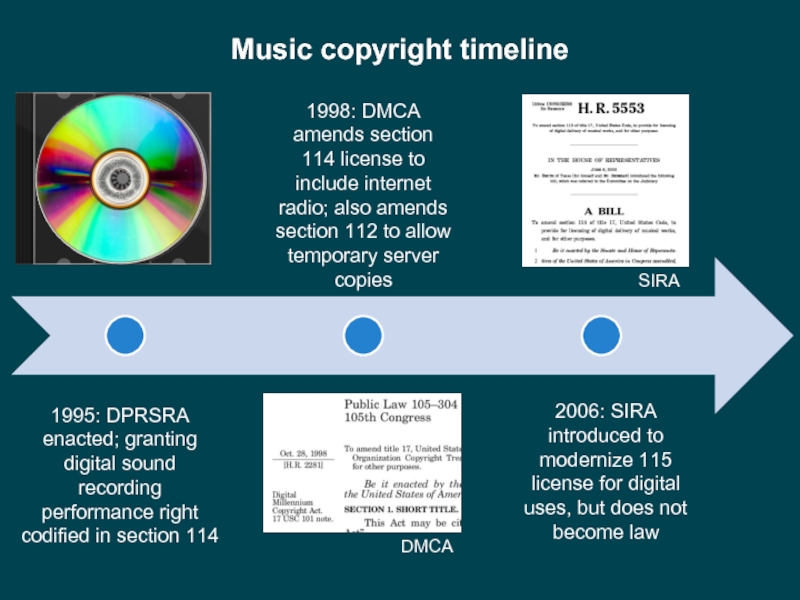

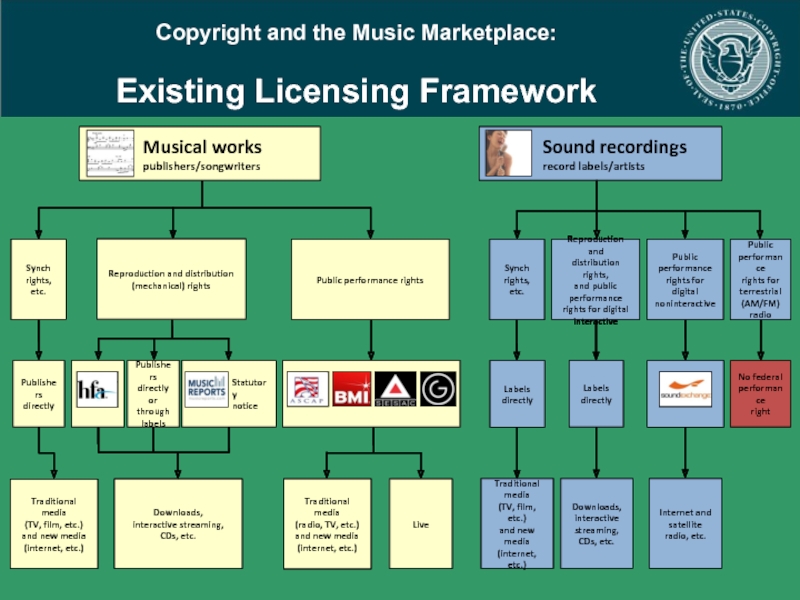
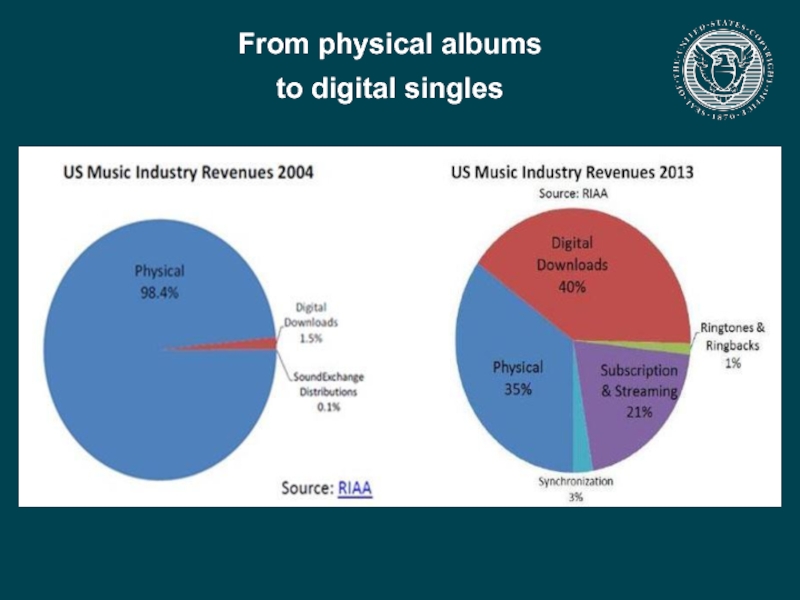
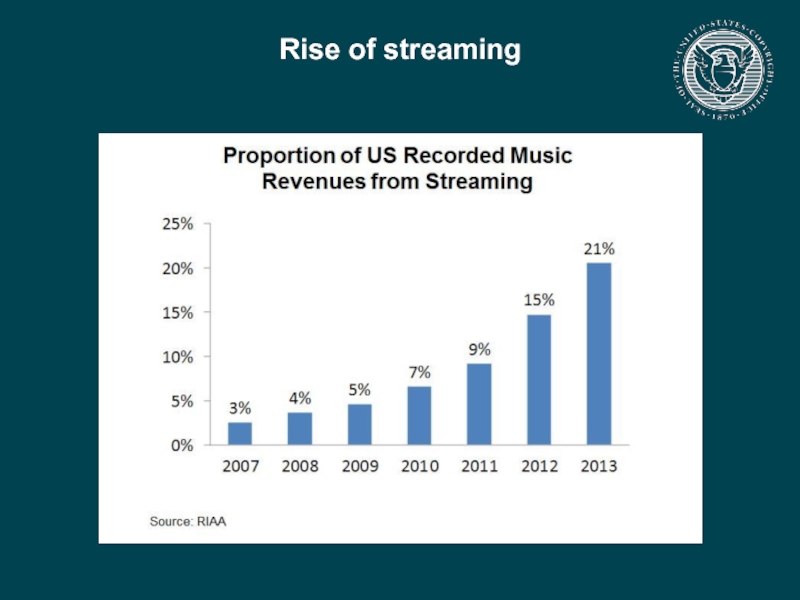

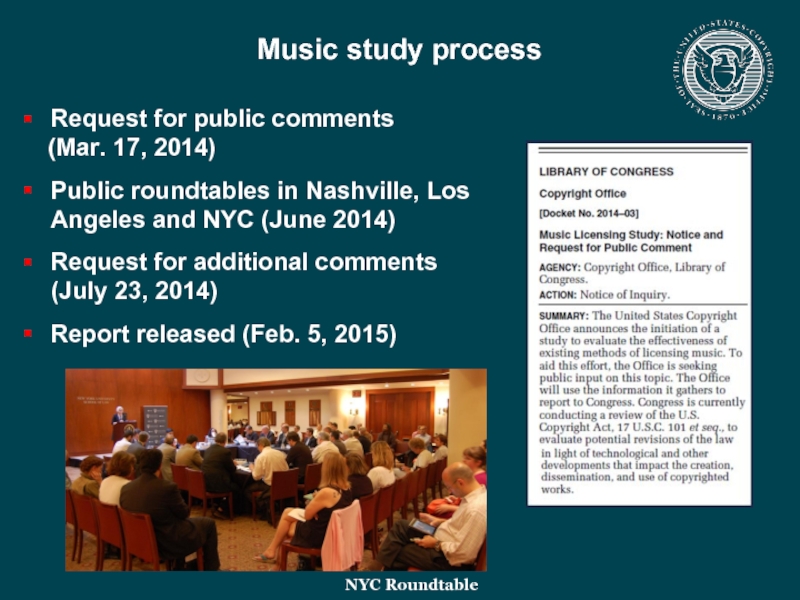
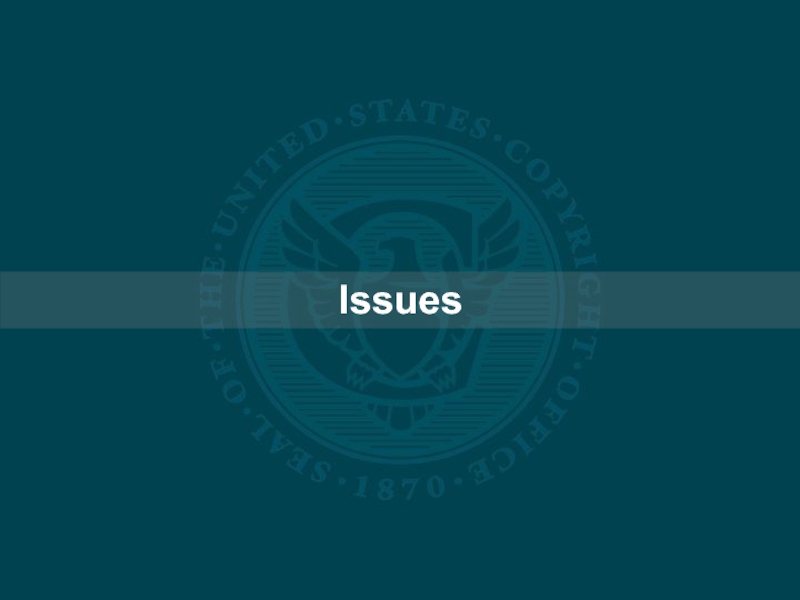
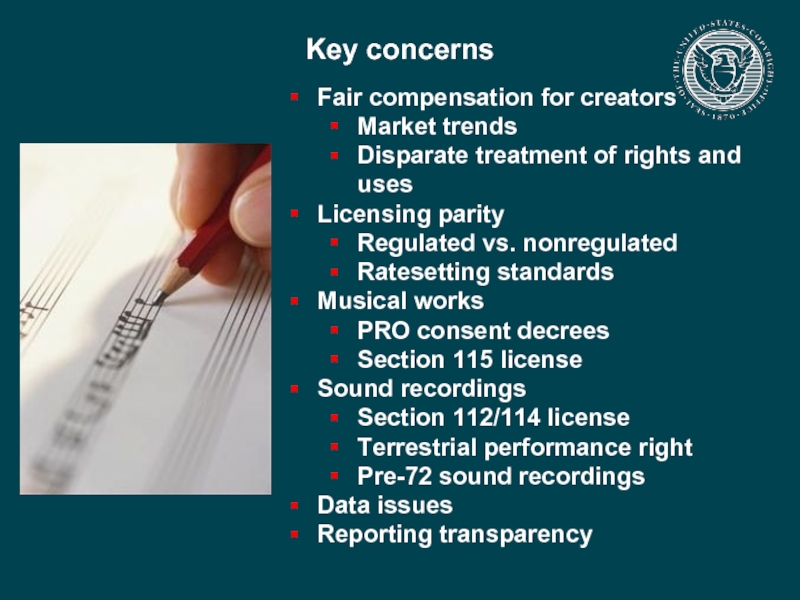
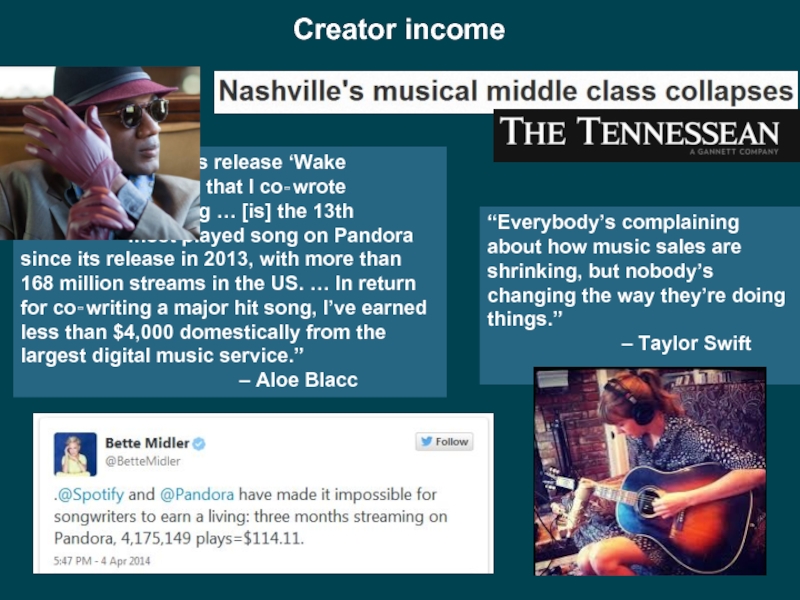
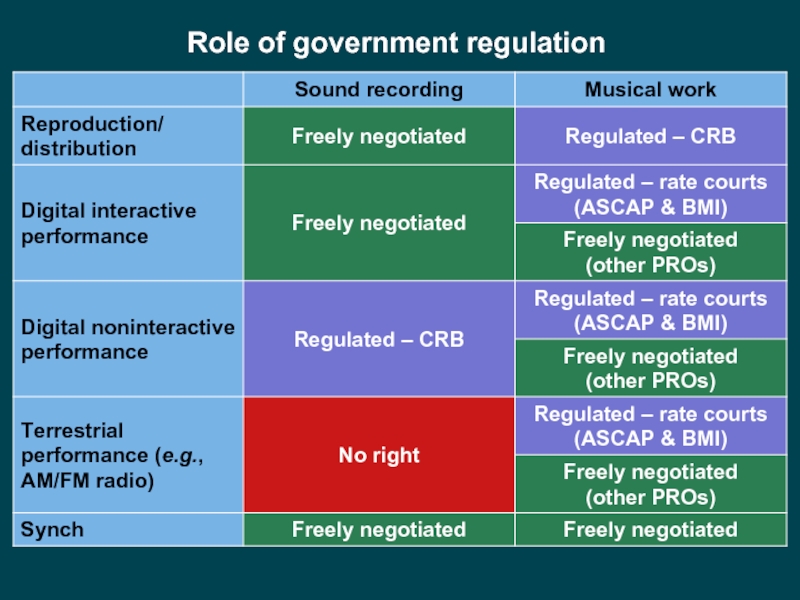
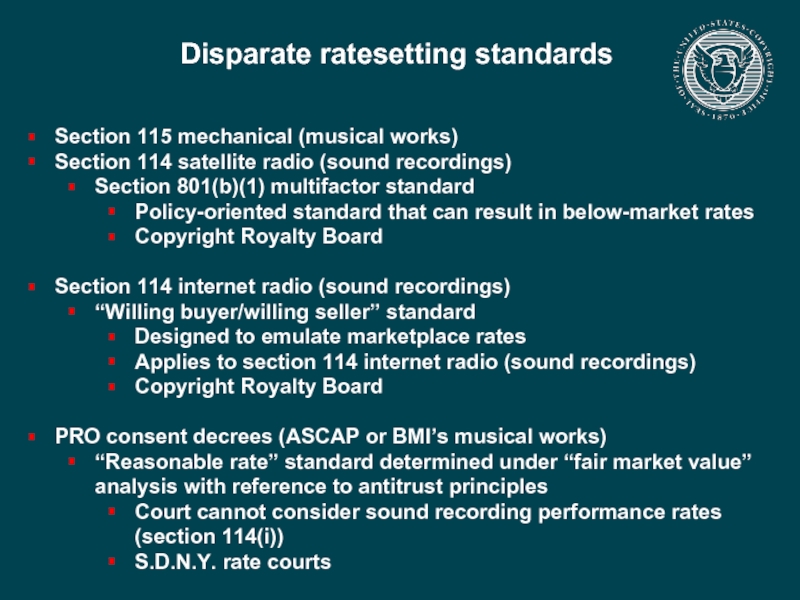
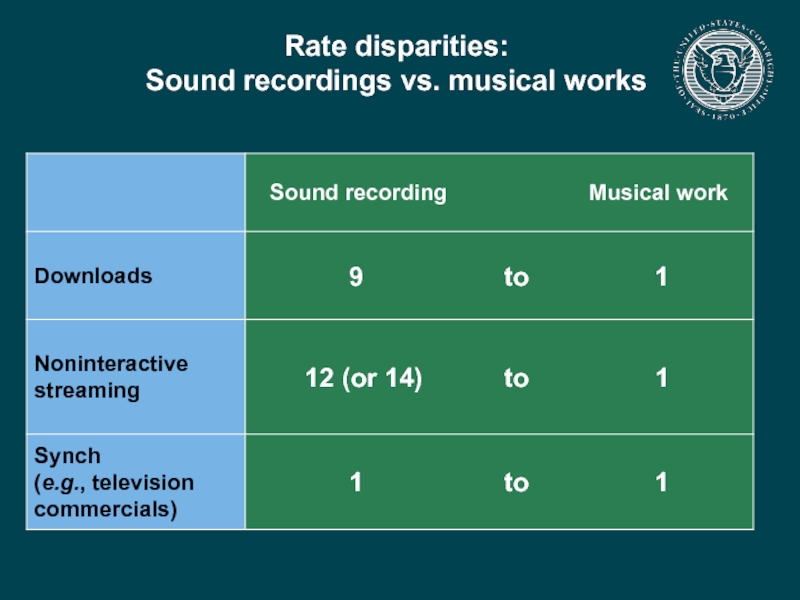
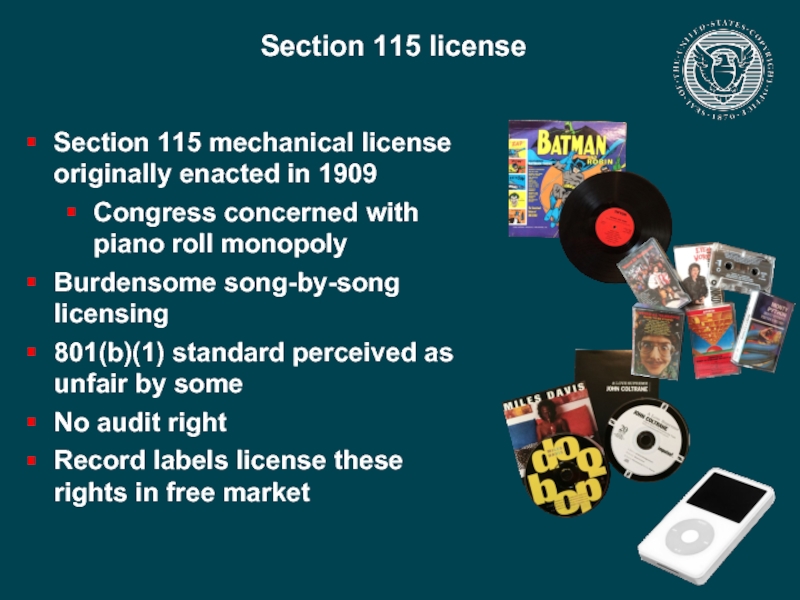
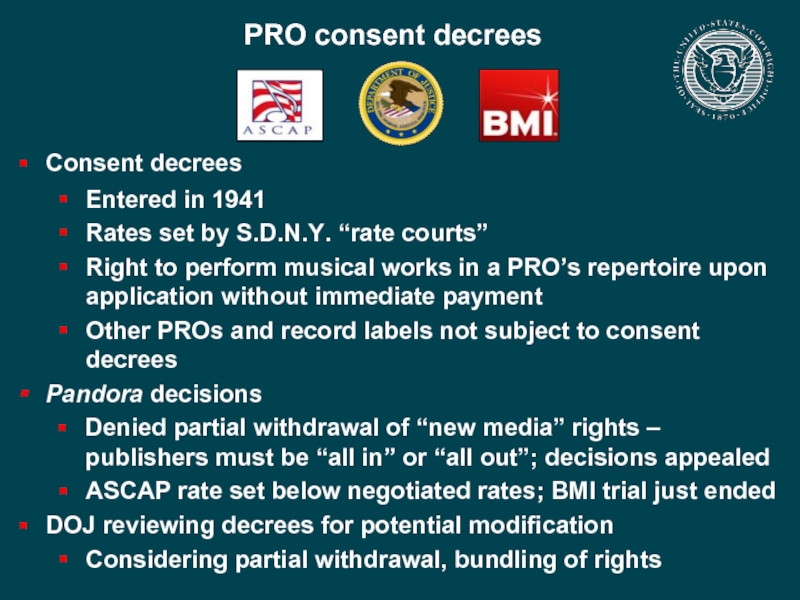

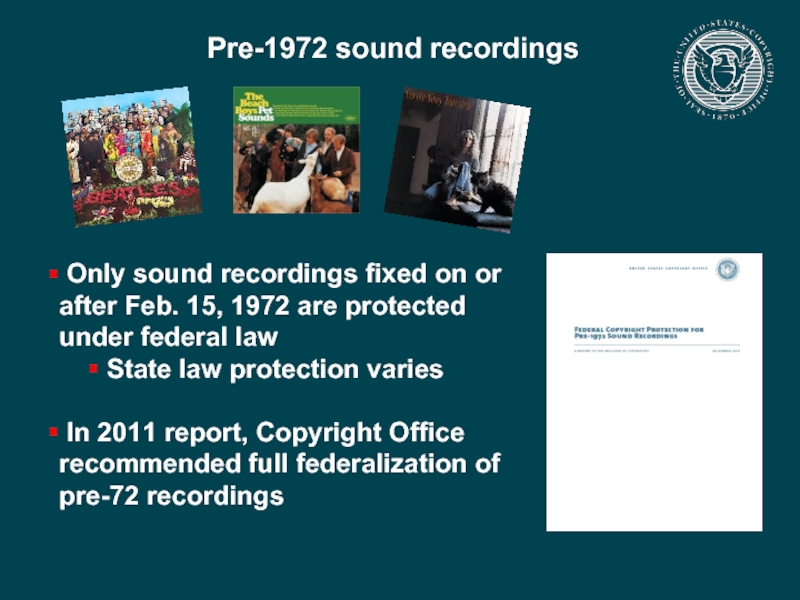
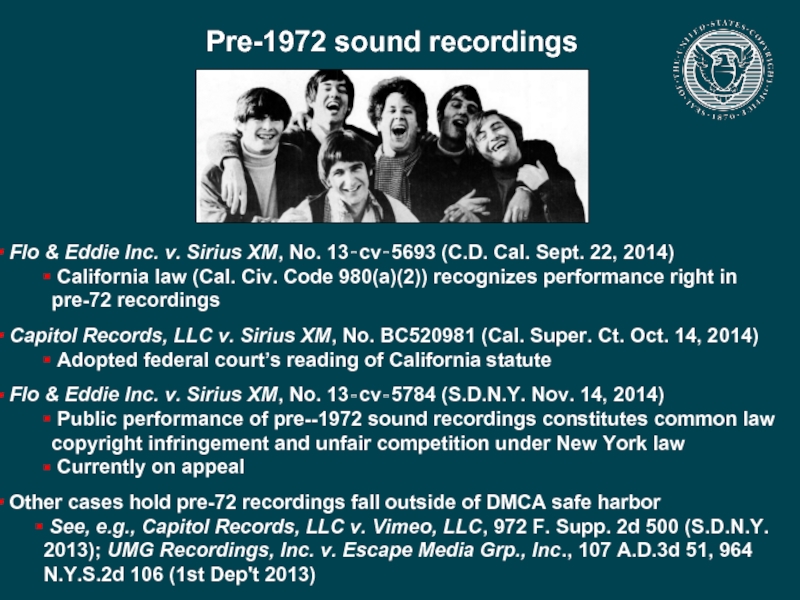
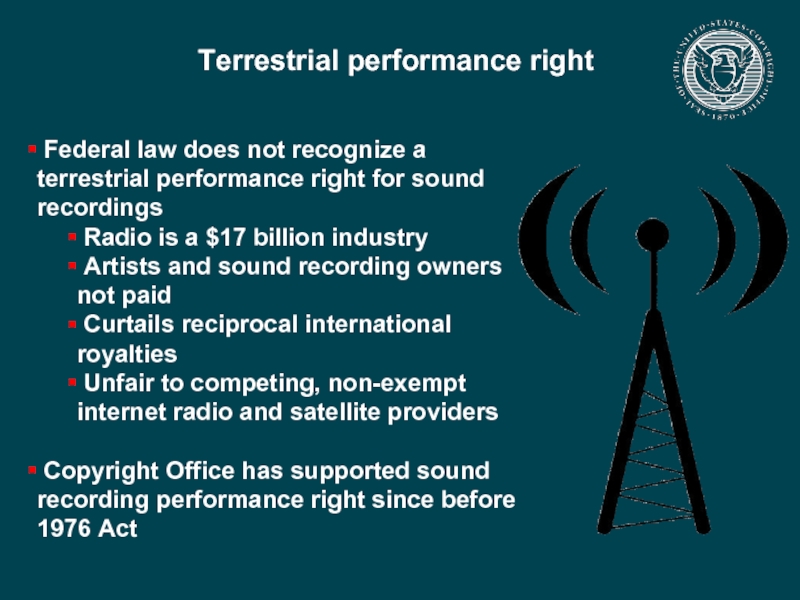
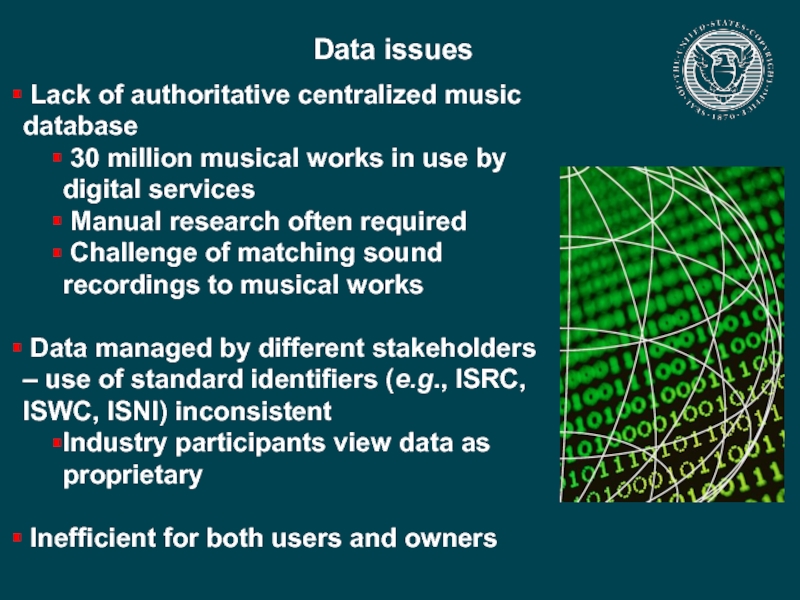

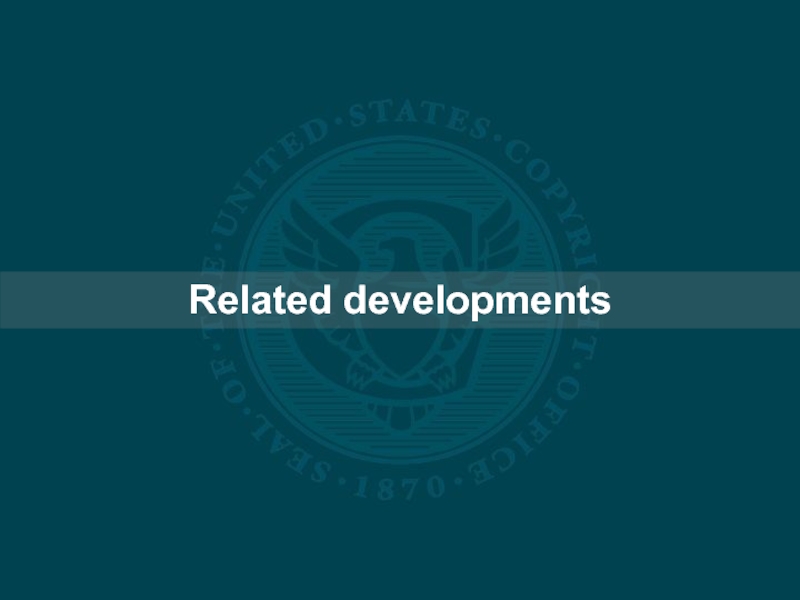
![Recent legislative proposals“[RESPECT] Act” (H.R. 4772) introduced by Rep. Holding (17 cosponsors)“Allocation for Music Producers](/img/tmb/3/216541/0f1e7366ca37d923e8cd1e270a315ed9-800x.jpg)


